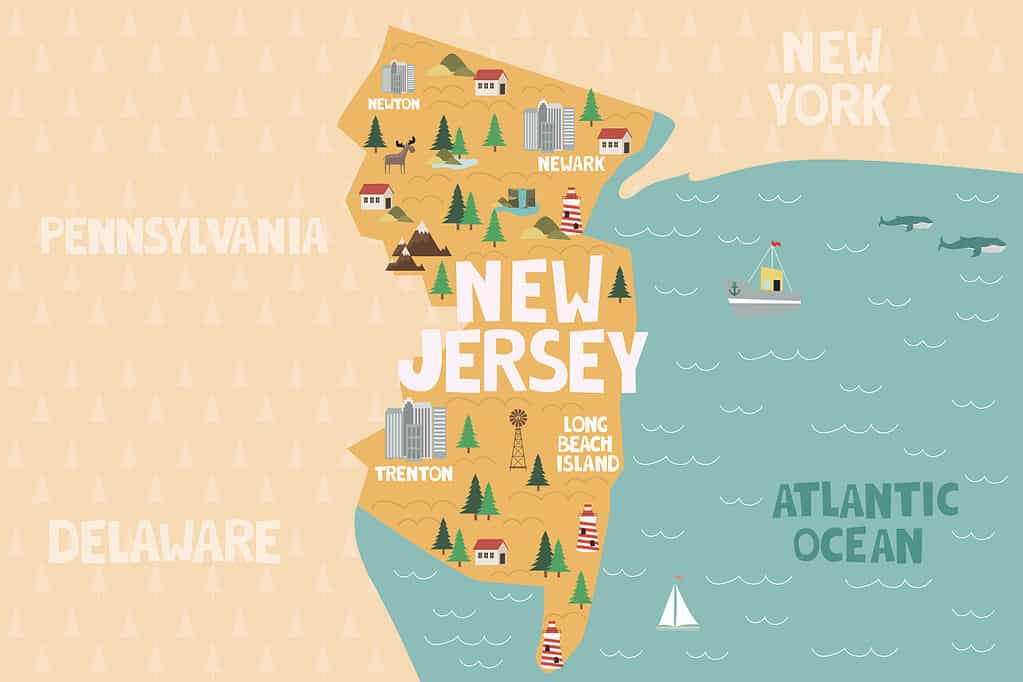New Jersey is a Mid-Atlantic state known for having four distinct seasons. Unlike some parts of the country that have a boiling hot season and then a cooler season, New Jersey’s temperatures are a tad more nuanced. However, that does not mean New Jersey is immune from unusually hot weather throughout the year. Discover the hottest June in New Jersey history and see why it was such a miserable time.
The Climate of New Jersey

New Jersey’s climate is mostly a humid subtropical one with cold winters and hot summers.
©iStock.com/BonneChance
The dominant Köppen climate of New Jersey is a humid subtropical type. Exceptions are in the far northwestern part of the state that has hot-summer or warm-summer humid continental types. Generally, New Jersey has cool winters and warm summers.
The winter months can see the effects of storms like Nor’easters which dump snow on the region. Meanwhile, the summer months can see thunderstorms, tornadoes, and hurricanes.
Usually, the hottest month in New Jersey is July, a month with an average high temperature of about 86 °F. However, August can also be very hot. Still, the hottest June in New Jersey had an average temperature that exceeded the average high temperature in July by almost two degrees.
Temperatures over 100 °F are rare in New Jersey. Meteorologists have recorded fewer than 50 days over 100 °F in the state dating back to 1865. However, the state has had several exceptionally hot summer days, including a day with a high temperature of 106 °F on June 28, 1969.
The hottest day ever recorded in New Jersey was July 10, 1936, when the mercury read 110 °F. New Jersey’s summer months can be very hot, and the lead-up to summer can be just as brutal in some cases.
The Hottest June in New Jersey History

Three heatwaves hit New Jersey in June 2010.
©Ed Connor/Shutterstock.com
The hottest June in New Jersey history was in 2010 when the average high temperature reached over 90 °F on 15 days, including three heatwaves lasting four days or longer each. This exceptionally warm June was as hot as the average July in terms of the average high temperature. The average high temperature in New Jersey during June 2010 was 87.6 °F, higher than the average in July by 1.7 °F!
The month featured three separate heat waves that became successfully hotter throughout the month. The first was between June 2 and June 6 where temperatures ranged from 90 °F to 93 °F. The next one started on June 20 and went on until June 24 with a high temperature of 97 °F on the final day. The last one was between June 26 and June 29 which saw temperatures of 91 °F, 92 °F, 95 °F, and 96 °F.
The hottest days during the month were:
- June 24- 97 °F
- June 28- 96 °F
- June 27- 95 °F
- June 23- 94 °F
- June 20- 94 °F
The end of the month was impressively hot. In fact, the month’s high average was lowered by a few unusually cool days including a high of 69 °F on June 9, 2010. Without those few days of cool temperatures in the 60s and 70s, this would have been a greater standout as the hottest June in New Jersey history.
The Impact of the Warmest June in New Jersey

People who spent time outside in June 2010 had to adapt to the hotter-than-usual weather.
©PeopleImages.com – Yuri A/Shutterstock.com
The hottest June in New Jersey brought with it many challenges related to the high temperatures. People started using their air conditioners in the state earlier and more frequently than usual. The lack of precipitation brought some challenges to farmers in the Garden State. However, these problems were nothing that people in the state were not used to facing.
Reports from the USDA mentioned that the lack of rainfall was a potential problem. The more pressing issue created by the hot weather was that some plants would finish their growing season early rather than wilting and dying.
Fortunately, the schools in New Jersey let out for summer vacation in the middle of June. So, schools did not have to face the choice of what to do with hundreds of students in high temperatures. Schools that have older buildings that lack air conditioning or have inefficient systems sometimes close when it’s exceptionally hot. Fortunately, that did not happen.
Despite the hot temperatures, only 7 people in the state died as a result of overheating in 2010. At least 10 years in the last two decades tied or exceeded that number of heat deaths in a year. In other words, despite being very hot, 2010 was not an especially deadly or harmful year.
The biggest challenges from the June 2010 weather were:
- Increased electricity usage
- An accelerated or truncated growing season for some crops
- General discomfort for laborers that worked outside
These problems were not significant compared to hotter summer months. Even though the hottest June in New Jersey smashed records, the heat was not dangerous to most people.
Lessons Learned from the Scorching June Temperatures

Sometimes, spending the hottest part of the day inside with air conditioning is the smartest thing a person can do.
©Andrey_Popov/Shutterstock.com
The hottest June in New Jersey was not a defining moment in the state’s history. However, it was beneficial in terms of making people prepare for increasingly hot temperatures, especially those that strike earlier in the summer.
The last 20 years have seen 9 of the 10 hottest summers on record in New Jersey. People have adapted to this trend in several ways, including:
- Investing in air conditioning in homes, businesses, and public spaces
- Spending more money on power resources
- Emphasizing hydration during summer months to stave off heat illnesses
- Staying inside during the hottest times of the day
The hottest June on record in the Garden State was a scorcher, but it was not much hotter than a typical summer month. So, the heat did not spur people to action or prompt many changes in the everyday lives of people.
The overall trend of warming in the state is worrisome for a few reasons. For example, the hot, dry weather continues to provide fuel for wildfires. A growing number of people using the state’s electrical infrastructure could pose a serious challenge leading to power shortages. These issues could be exacerbated in the future if the summers continue to get hotter and if hot weather arrives earlier in the year.
Thank you for reading! Have some feedback for us? Contact the AZ Animals editorial team.








